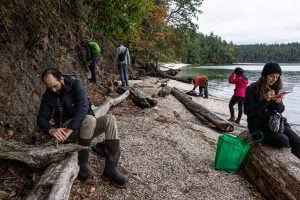The very nature of old-growth provides an opportunity to transcend that invisible line: in Redwood National and State Parks in California, chief ranger Stephen Troy says, the trees are “the rhino horn of the American West.” The same can be said of cedar and Douglas fir ecosystems, their branches dripping with spools of moss and their trunks towering into the sky. These are trees that invoke awe, through height and age and circumference. It is very difficult to stand in a grove of Sequoia and not be bowled over by their beauty.
This book primarily investigates tree poaching from national and provincial parks and forests in the Pacific Northwest of the United States and Canada. These trees are only hours from my backyard in British Columbia’s interior, and I have spent years trying to understand why someone might steal one. My curiosity brought me face-to-face with a form of deforestation rarely discussed, which springs from some of the most pressing social issues of the 20th and early 21st centuries.
What draws me to this story is not the amount of money that the missing wood is worth, nor even the knowledge that a single missing tree has a negative impact on climate change, though both are crucial considerations. Instead I wonder how someone who lives surrounded by the crushing beauty of a redwood forest can simultaneously love it and kill it; can see themselves as so entwined with the natural world that destroying part of it comes to feel like another stage in its life cycle. Timber poaching is a large, physical crash of a crime, and it is rooted in a challenge that stretches across North America: the disintegration of community in the face of economic and cultural change.
Studying timber poaching quickly opens a window into the trickle-down effects of environmental and economic policies that disregard and marginalize the working-class people who not only live among the trees but rely on them to survive. It’s a difficult tale—one tinged with both anger and beauty, arising from rampant expansion and desire. The forest is a working environment, and displacing that work deprives many people of money, community, and a uniting identity. Many tree poachers express a longing for something that a tree represents: the deep-rooted underpinnings of home. The ancient Greeks called this feeling nostos, the root word of nostalgia—a searching homesickness that comes from wrenching separation.
People have “taken” wood for centuries, but wood has also been taken from us, cloistered within fences and marked boundaries on maps. Throughout history, removing land from community use often caused a wreckage, and while every poacher’s story is unique, they all act out of the simmering need that followed. So why might someone steal a tree? For money, yes. But also for a sense of control, for family, for ownership, for products that you and I have in our homes, for drugs. I have begun to see the act of timber poaching as not simply a dramatic environmental crime, but something deeper—an act to reclaim one’s place in a rapidly changing world, a deed of necessity. And to begin to understand the sadness and violence of poaching, we need to consider how a tree became something that could be stolen in the first place.






